The Museum Collections
Introduction
I. History and Art Collection
1. Icons of the 14th – 19th centuries
icons of the 14th – 17th century
2. Jewelry art of the 14th – 20th century
jewelry art of the 14th – 17th century
jewelry art of the 18th – 19th century
the european silver 14th - 19th centuries
3. Small-size sculptures (works of metal, wood, bone)
XI – the beginning of the XX century
Small-size sculptures 11th – 17th century
Small-size sculptures 18th – early 20th century
enamel of Troitza masters 15-8th – early 20th century
5.Embroidery, lace, textiles of the 14th - early 20th century
icon and ornamental embroidery
gold and silver lace
6.Painting of the 18th – 21st centuries
painting of the 18th – 19th centuris
painting of the 20th – 21st centuris
II.Manuscripts and old printed books of the 14th – 17th century
IV.Lithography of the 18th – 19th century
V.Numismatics
VI.Medals of the 18th - early 20th century
VIII.Archeology collection
IX. Russian folk and applied and decorative art of the 17th – 21st c.
1. Artistic wood
folk carved and painted wood
wooden toys
house carving of Sergiev Posad
Khokhloma and Gorodets painting
2. Artistic textiles
embroidery and weaving
printed textiles and lace
Russian shawls
folk costumes
folk garments
printed cotton kerchiefs
|
Archaeological collections (p. 2)
|
Antiquities of Fatyan cultures – the funeral round-bottom spherical ceramic ware, stone polished axes-hammers with a round aperture date from the Bronze Age. The Fatyan’s people achieved the highest skill in manufacturing stone drilled fighting axes-hammers. A man's skull from a tomb of one Kuzminsky burial ground (at the Kuzmino village of the Sergiev-Posad area) has been especially studied in details by known Soviet anthropologist M.M.Gerasimov and serve to he as the basis for reconstruction of the head of the person of Fatyan culture (it is in an exposition).
The collection of antiquities of the early Iron Age and the early Middle Ages descend from excavation of the Kikinsky site of ancient settlement on the Velya River. Iron spears and arrows, knifes and awls are found on a site of ancient settlement along with bone tools of work and the weapon. Iron slags, clay nozzles-tubes for air forcing in the little blast furnace, little ladies - clay spoons for bronze pouring in process manufacturing of ornaments are found on the Kikinsky site of ancient settlement. These are pendants, ear rings, plaques-braids, signet-rings, temporal rings, clasps on clothes. Ceramic crockery of the early Iron Age - flat-bottomed pots (to 20 liter volume), bowls, tiny vessels - are roughly model from clay, their ornament is extremely modest.
Beads, foundry forms, rattles were produced also from ceramics. Typical finds for Dyakovsky settlements are moulded of clay so-called “plummets of Dyakov type”. They, as a rule, have a conic form, with gear edges, in the centre - the transparent channel.
|

Model of the burial of the Fatyan culture. The Bronze Age. |

Reconstruction of a head of the man. The Kuzminsky burial ground of the Fatyan culture. The Bronze Age.The author - M.M.Gerasimov |
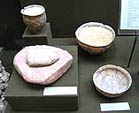
Ceramic vessels and corn-grater. The Kikinsky site of ancient settlement. The early Iron Age. |
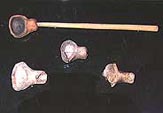
Ceramic ladies. The Kikinsky site of ancient settlement. The early Iron Age. |
|
The Ratkovsky soil burial ground belonging, apparently, to medieval Finns – “muromian” and “merya” - was opened in 1996 on the Dubna River. Date VII-IX centuries. The Funeral ceremony is similar to others “merya” and “muromian” burial grounds: remains of the cremation dead body with the burnt down and melted off subjects were located in small superficial holes or land constructions - so-called “small houses dead”. The burial ground stock (that put in a tomb together with late) is various and presented by metal details of clothes, ornaments, work tools, pottery.
Bronze ornaments of a female suit are especially various: on forehead corolla from spiral pierceable, sometimes in a combination with whole ones, intercepted by lamellar holders with a stamping ornament, head plaits were decorated by the bronze opened ringlets, the small round not closed temporal rings from a round wire; rustling pendant-brooches. “Rustling bronze” was a necessary part of a female suit of “merya” and “murom” - at movement bronze protectors utter a ring - magic means for exile of "malicious forces”.
|
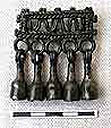
Rustling pendant. Finno-Ugric soil-ground burial from Ratkovo. 6-9th centuries. |

Fastener-sjulgama. Finno-Ugric soil-ground burial from Ratkovo. 6-9th centuries. |

Stone foundry form. Finno-Ugric soil-ground burial from Ratkovo. 6-9th centuries. |
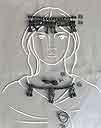
Reconstruction of ornaments of a female suit. Finno-Ugric soil-ground burial from Ratkovo. 6-9th centuries. |
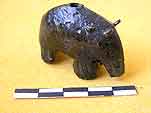
Bronze pendant-bear. Finno-Ugric culture. Radonezh. 7th century.
|
|
The collection of things from funeral complexes of Old Russian barrows 12-13th centuries investigated at the Veskovo village on the coast of Pleshcheevo lake is interesting. Modelled and circular funeral vessels, glass, gold-glass, cornelian and a crystal beads, female breeding ornaments - temporal rings were found in tombs of ancient slavonian-krivichy.
|

Glass and cornelian beads. Old Russian burial mound at the Veskovo village on the coast of Pleshcheevo lake. |

Glass and gold-glass beads. Old Russian burial mound at the Veskovo village on the coast of Pleshcheevo lake. |
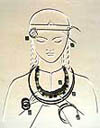
Reconstruction of ornaments of a female suit. Old Russian burial mound at the Veskovo village on the coast of Pleshcheevo lake. |

Ceramic modelled vessels. Old Russian burial mound at Veskovo village on the coast of Pleshcheevo lake. |

Ceramic potter's vessels. Old Russian burial mound at Veskovo village on the coast of Pleshcheevo lake.
|
|


